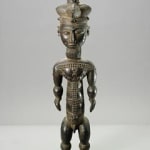Attye Wooden Ancestor Sculpture, 20th Century CE
Wood
22
PF.6013
Further images
The Attye people are one of the major tribes that inhabit the Lagoon region of the southeastern Ivory Coast. Artistically, they are heavily indebted to their neighbors, the Baule. This...
The Attye people are one of the major tribes that inhabit the Lagoon region of the southeastern Ivory Coast. Artistically, they are heavily indebted to their neighbors, the Baule. This sculpture depicts a man standing erectly with his arms held two his side. His hair has been groomed into and elaborate coiffure that is reflective of his position and rank within Attye society. His hair rises in a cruciform shape of four arching crests surmounted by a central bun. He also wears a carefully trimmed beard that falls from his chin. By far, the most fascinating feature of this glorious sculpture is the intricately rendered keloid scarification that decorates his body. Such scarifications were considered both marks of beauty as well as signs of elite status. His back, the back of his neck, his face, chest, and shoulders are all dotted with scars shaped like cowrie shells. Meanwhile, the front of his neck, the top of his chest, and his elongated stomach are covered with bands featuring a grid pattern. These remarkable decorations amplify the beauty of both the sculpture and the persona it represents. This sculpture probably commemorates a deceased ancestor who was continually revered in the form of this work of art. In a society void of photography, sculptures were used to memorialize and honor the dead. In fact, the deceased were believed to play an active role in the lives of their descendents from beyond the grave. Thus such a work is not just a passive record of an individual but an active tool through with the favor of the deceased’s spirit can be influenced for the benevolence of the entire community.







